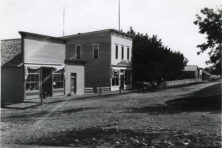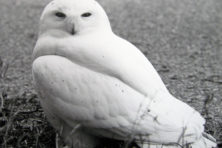Fish Creek Student Tours the Arctic with Students on Ice
- Share
- Tweet
- Pin
- Share

A snowbird is the term given to Door County’s large population that flees the cold winters for warmer climates. Makayla Swain, Fish Creek native and recent Gibraltar graduate, did just the opposite. This summer, Swain spent two weeks traveling the Arctic Circle by boat with 114 other students from around the world.
“It’s to inform students about the Arctic because it is a widely forgotten area,” said Swain. “You think of the Arctic and you don’t really think of much up here. But it’s important to know those towns, that there’s an agreement between people and nature.”
Swain was the only student from the Midwest and one of eight from the United States. Students hailed from Malaysia, Kenya and primarily Canada, where the program is headquartered. She explained that even though many of the students lived in the high Canadian country, few were able to experience the true Arctic.
Not knowing much about the program, Swain found weeks before getting accepted to be a bit chaotic.
“It’s very selective,” said Swain. “I remember late nights with my sister going over every essay, nitpicking every word. I was already a little later in the application process than everyone else.”
Swain said she learned of the program upon receiving a text from her dad at 4:30 in the morning. He had been listening to the radio on a drive into Canada and heard a program for Students on Ice. Knowing his daughter’s desire to see the Arctic, he messaged her.
“It was too good to be true,” said Swain.
The program collaborates with international organizations such as the World Wildlife Foundation, the United States Embassy, Parks Canada, and the Canadian Museum of Nature.
During two weeks on board with botanists, paleontologists, marine biologists and a representative from NASA, Swain learned about life in the Arctic and how drastically it has been changing.
“We saw glaciers that were decreasing at nine centimeters a day and talked to people in communities that told us about how they used to just walk to the glaciers from their houses and now it’s a couple miles walk just to get to them,” said Swain.
In a visit to Ilulissat, touted as the place where the iceberg that sunk the Titanic most likely originated, the group tied 16 dinghies together and traveled out into the frigid waters, face-to-face with 10-story tall sheets of ice.
“It showed us that even though we live all over the world, we don’t really notice climate change but it’s actually happening very rapidly up there so it’s to inform of climate change,” said Swain.
But climate change was not the only angle that educators took on the trip. On a landing at Devon Island, known as “Mars on Earth,” a NASA representative took the opportunity to explain the ongoing expedition to visit Mars. Biologists talked about the vibrant and dynamic life that takes place within a single small pond and Swain steered an underwater drone around the waters near Greenland.
“Every day you would have a landing, so we would go up to a small town or go to isolated areas in the fjord,” said Swain. “It focused on opening kids eyes to different professions.”
Swain is now in her first year at the University of Wisconsin-Green Bay studying elementary education. She has always enjoyed working with kids and, while the Arctic workshops did not completely shift her professional trajectory, she did have some experiences that reinforced her passion for children and education.
“There was one day when we were in Uummannaq, it’s a small island in Greenland,” she explained, promising to provide the spelling to each town mentioned. “There was a little girl and her name was Amy. We did not know how to speak Greenlandic at all. I’d worked with kids before and I’d known that’s kind of what I want to do. I remember sitting in the church in Uummannaq, she was sitting one row behind me and my friend Alex. We talked to her a little bit. She would braid our hair when we weren’t looking, she put her hand up to our hands, it was just the coolest experience. This is what I want to do, working with kids is what I want to do.”
Few small town natives get the opportunity to field test their ideas of careers before heading to college. Swain felt support from everyone at Gibraltar in embarking on an education that few public schools, rural or urban, can provide. And Swain, like many other youths in Door County, always had a driving desire to go places.
“Growing up in a small town, you are very sheltered, but I’d always wanted to just see what’s outside of this town,” said Swain. “I’ve always wanted to go to different countries, experience different cultures, things like that. It’s definitely scary to do that and to leave something that’s so familiar and already so perfect. Going out and seeing how these people live their life, and they live in even smaller towns than us secluded on islands, you learn so much about how a community does mean a lot.”
Swain hopes to make it back to the Arctic someday and she said the degree she gets in four years might even have Environmental Science written on it as well.





